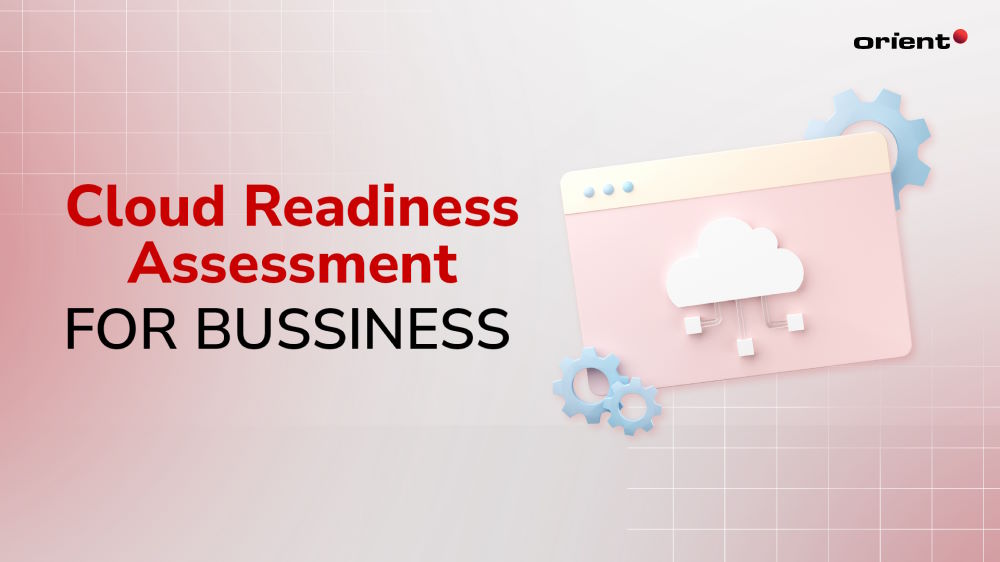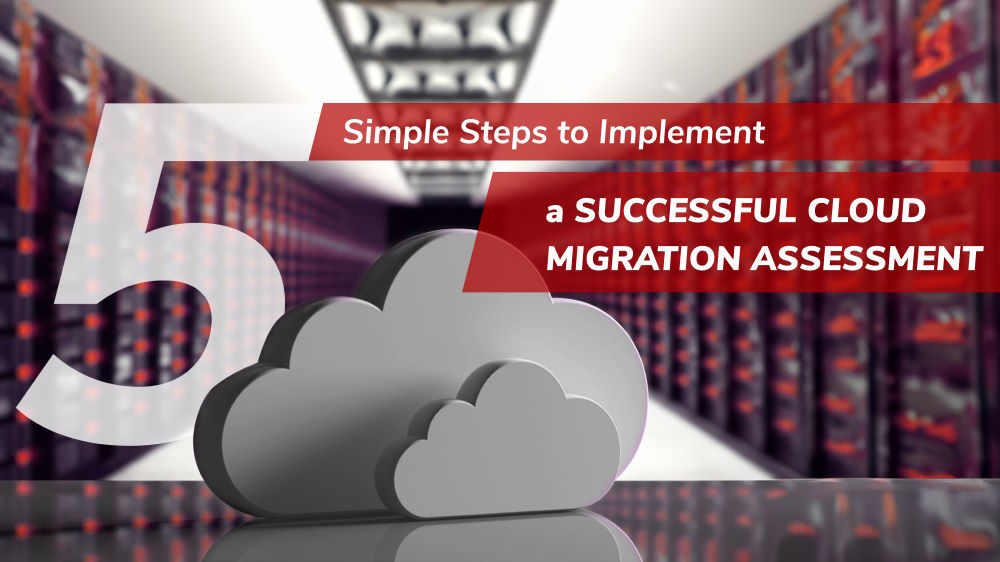Is Your Business Ready for the Cloud? Cloud Readiness Assessment Will Answer

Content Map
More chaptersIn today’s digital era, cloud adoption is not just an option; it’s a strategic imperative. As of 2023, a staggering 94% of enterprises have embraced cloud services, with 67% of enterprise infrastructure soaring in the cloud space. With the global cloud computing market ballooning to an impressive $480.04 billion, it’s clear that the cloud is the future’s backbone. With more and more organizations looking to leverage cloud benefits, it’s essential to ensure that your organization is ready for the move. However, cloud migration is a daunting task, and without proper preparation and planning, such a process can quickly become a costly and time-consuming endeavor. That’s where cloud readiness assessment comes in.
A cloud readiness assessment involves evaluating an organization’s IT environment, applications, and data to determine its preparedness for a move to the cloud. By conducting a cloud readiness assessment, organizations can identify potential roadblocks, estimate costs, and develop a comprehensive migration plan. It’s the compass that guides you through the complexities of the cloud migration process, ensuring your voyage is smooth, and your organization is truly cloud-ready. Are you prepared to take the leap in the cloud journey? Let’s find out together.
Get to Know Cloud Readiness Assessment

Cloud readiness assessment is a comprehensive evaluation of a company’s existing infrastructure, processes, and strategies to determine its ability to migrate and operate effectively in the cloud environment (public or private cloud). It involves analyzing technical, operational, and business aspects to identify any gaps or challenges that need to be addressed before undertaking cloud adoption.
The primary purpose of a cloud readiness assessment is to provide organizations with insights into their readiness for cloud adoption with minimal impact on business operations. By conducting a systematic evaluation, businesses can identify potential barriers, risks, and opportunities associated with the migration to the cloud. This assessment serves as a roadmap, guiding organizations in making informed decisions regarding cloud adoption strategies, resource allocation, and mitigating potential challenges.
There are several types of cloud readiness assessments that organizations can undertake, depending on their specific needs and objectives:
- Technical Readiness Assessment focuses on evaluating the organization’s existing IT infrastructure, systems, and applications. It involves analyzing factors such as hardware compatibility, software dependencies, network capabilities, and security measures. The technical readiness assessment helps identify any technical limitations or modifications required for a smooth transition to migrate to the cloud.
- Operational Readiness Assessment examines the organization’s operational processes, workflows, and policies. It assesses aspects such as governance, compliance, data management, and disaster recovery capabilities. This assessment helps identify any operational gaps or areas that need improvement to align with cloud best practices.
- Financial Readiness Assessment analyzes the organization’s cost structure, budgeting, and financial strategies. It involves evaluating the potential costs and savings associated with cloud adoption, including infrastructure expenses, licensing fees, and ongoing maintenance costs. This assessment helps organizations determine the financial feasibility and return on investment (ROI) of migrating to the cloud.
- Organizational Readiness Assessment focuses on evaluating the readiness and capacity of the organization’s workforce to adapt to cloud services. It assesses factors such as employee skills, change management capabilities, and cultural readiness for embracing cloud-based solutions. This assessment helps organizations identify training needs and develop strategies to ensure a smooth transition for the workforce.
Popular Cloud Readiness Assessment Tools

There are various tools available for conducting cloud readiness assessments. Some of the most popular tools include:
Microsoft Azure Migrate
Microsoft Azure Migrate is a widely recognized cloud readiness assessment tool that assists organizations in evaluating their on-premises infrastructure for migration to the Azure cloud. It offers a range of assessment features to ensure a smooth and successful transition. Azure Migrate provides insights into workload dependencies, performance characteristics, and estimated costs associated with the migration process. By collecting data from on-premises systems, the tool generates detailed reports and recommendations, helping organizations plan and execute their cloud migration strategy effectively.
Cloudamize
Cloudamize is a comprehensive cloud readiness assessment platform that supports multi-cloud environments, making it suitable for organizations with diverse cloud adoption strategies. By analyzing an organization’s infrastructure, applications, and workloads, Cloudamize offers valuable insights into migration feasibility, performance considerations, and cost optimization opportunities. The tool generates detailed reports and provides recommendations for optimizing cloud resources, including rightsizing instances, identifying potential cost savings, and enhancing overall performance in the cloud environment.
Google Cloud Migration Assessment
Google Cloud Migration Assessment is a robust tool provided by Google Cloud Platform (GCP) to evaluate an organization’s readiness for migration to its cloud ecosystem. It employs an assessment framework that analyzes an organization’s existing infrastructure, applications, and data to generate readiness scores and recommendations. The tool provides insights into cost optimization opportunities, security enhancements, and performance improvement recommendations. With its comprehensive assessment capabilities, organizations can make informed decisions and develop a well-structured migration plan aligned with Google Cloud best practices.
Cloud Readiness Assessment Checklist
To leverage those tools effectively, you should consider creating your cloud readiness assessment checklist—a strategic roadmap to navigate your organization’s successful cloud-hosted staging environment. Let’s dive into the key factors in the checklist:
Technical Infrastructure and Compatibility
Assessing the existing technical infrastructure is crucial to determine its compatibility with cloud services. This involves evaluating hardware, networking infrastructure, and system requirements. It is essential to identify any potential limitations or dependencies that may impact the migration process. Legacy systems, specialized hardware, and network connectivity should be carefully considered to ensure a seamless transition to the cloud.
Scalability requirements should also be evaluated to determine if the existing infrastructure can support future growth in the cloud environment. Evaluate your software products and workloads to determine their suitability for the cloud. Consider factors such as performance requirements, integration needs, and customization considerations. This assessment will help you identify any modifications or optimizations required for a successful migration.
Data Security and Compliance
Security requirements are paramount when moving to the cloud. Conduct a thorough analysis of existing security measures and evaluate their compatibility with cloud environments. Consider the sensitivity and classification of data to determine the appropriate security controls and encryption methods required. Compliance requirements, such as GDPR or HIPAA, must be met in the cloud environment. Additionally, organizations should assess the data residency requirements and ensure that the chosen cloud provider can meet specific data sovereignty regulations, particularly if you operate in multiple regions or countries.
Cost and Budget Considerations
Evaluating the financial aspects of cloud adoption is essential to make informed decisions. Assess the organization’s current IT budget and determine the financial feasibility of migrating to the cloud. Consider potential cost savings and return on investment (ROI) opportunities that cloud adoption can offer. Factors such as infrastructure costs, licensing fees, data transfer costs, and ongoing operational expenses should be carefully analyzed. Conduct a comprehensive cost-benefit analysis to compare the total cost of ownership (TCO) of on-premises infrastructure with that of the cloud. Identify potential cost savings and cost optimization opportunities. This analysis will help you establish a realistic budget for your cloud migration project.
Staff Skills and Business Workflows
Assess the skills and expertise of the existing IT staff to determine if they have the necessary knowledge to manage cloud-based systems. Identify any skills gaps and training requirements that may arise during the migration process. Cloud technologies and platforms often require specific skills, such as cloud architecture, security, and deployment. Consider investing in training programs or hiring cloud experts to ensure a smooth transition and effective management of cloud resources.
Analyze existing business processes and workflows to identify areas that may be impacted by cloud adoption. Evaluate how the cloud can enhance or transform these processes to deliver improved efficiency, scalability, and agility. Assess application dependencies, integration requirements, and potential workflow changes that may be necessary. Consider how the cloud can enable collaboration, remote work capabilities, and scalability to support business growth and innovation.
Developing a Migration Plan
Start by gathering all the necessary data and information about your current IT environment. Collect information on performance metrics, resource utilization, and any ongoing IT projects. Additionally, gather insights into your organization’s business objectives and future growth plans. This data will provide a solid foundation for your assessment.
Based on the findings from the assessment, develop a well-defined migration plan. Prioritize the systems, applications, and processes that are suitable for migration to the cloud. Define a phased approach, taking into account dependencies and potential risks. Determine the necessary resources, timelines, and milestones for each phase of the migration. Develop a contingency plan to address any unforeseen challenges that may arise during the migration process. Consider engaging with cloud migration experts or consultants to ensure a smooth and successful transition.
Real-World Examples of Successful Cloud Migrations
A well-prepared cloud readiness assessment is a crucial step for organizations considering migration to the cloud. It’s the beacon that guides ships through the fog, the map that leads explorers to treasure. Here, we unfold the stories of trailblazers who navigated through the clouds with precision and foresight due to effectively constructed cloud readiness assessments, along with lessons learned from their experiences.
Netflix
Netflix, the renowned global streaming service, embarked on a significant cloud migration journey to enhance its scalability, agility, and global reach. By transitioning its infrastructure to the cloud, specifically Amazon Web Services (AWS), Netflix achieved unprecedented scalability, enabling it to seamlessly handle massive spikes in user demand. The cloud’s flexible and on-demand resources, combined with Netflix’s adoption of a microservices architecture, allowed them to deliver personalized content to millions of users worldwide.
Lessons learned:
- Start small: Netflix began its migration with a single service, gradually moving more and more services to the cloud over time.
- Prioritize security: Netflix implemented a number of security measures, including multi-factor authentication, encryption, and regular security audits.
- Focus on automation: Netflix automated many of its IT processes, including deployment, scaling, and monitoring.
Capital One
Capital One, a prominent financial institution, embarked on a cloud migration to optimize its technology infrastructure, improve operational efficiency, and accelerate innovation. By leveraging the cloud, specifically Amazon Web Services (AWS), Capital One transformed its IT operations, enabling rapid development and deployment of digital services. The cloud’s scalability and pay-as-you-go model allowed Capital One to optimize costs and dynamically scale resources as needed. Furthermore, the migration empowered Capital One to leverage advanced data analytics and machine learning capabilities, resulting in more accurate risk assessments and personalized customer experiences.
Lessons learned:
- Conduct a thorough assessment: Capital One’s assessment included a detailed evaluation of its current IT infrastructure, applications, data, and workloads. This helped Capital One identify potential roadblocks and develop a detailed migration plan.
- Prioritize training and education: Capital One invested heavily in training its employees on cloud technologies and best practices.
- Focus on DevOps: Capital One embraced a DevOps culture, with a focus on continuous integration, continuous delivery, and infrastructure as code.
Overall, these examples demonstrate the importance of conducting a thorough cloud readiness assessment before migrating to the cloud. By drawing insights from these experiences, businesses can embark on their cloud migration journeys with confidence and pave the way for enhanced agility, scalability, and business growth.
At Orient Software, we provide a comprehensive range of services to help businesses overcome challenges and make your cloud adoption process easy and seamless. Our team of experts in cloud technology and the use of cutting-edge tools ensure a smooth transition without any disruptions. Contact us; you will gain dedicated experts focused on transforming your cloud journey into a source of competitive advantage.







